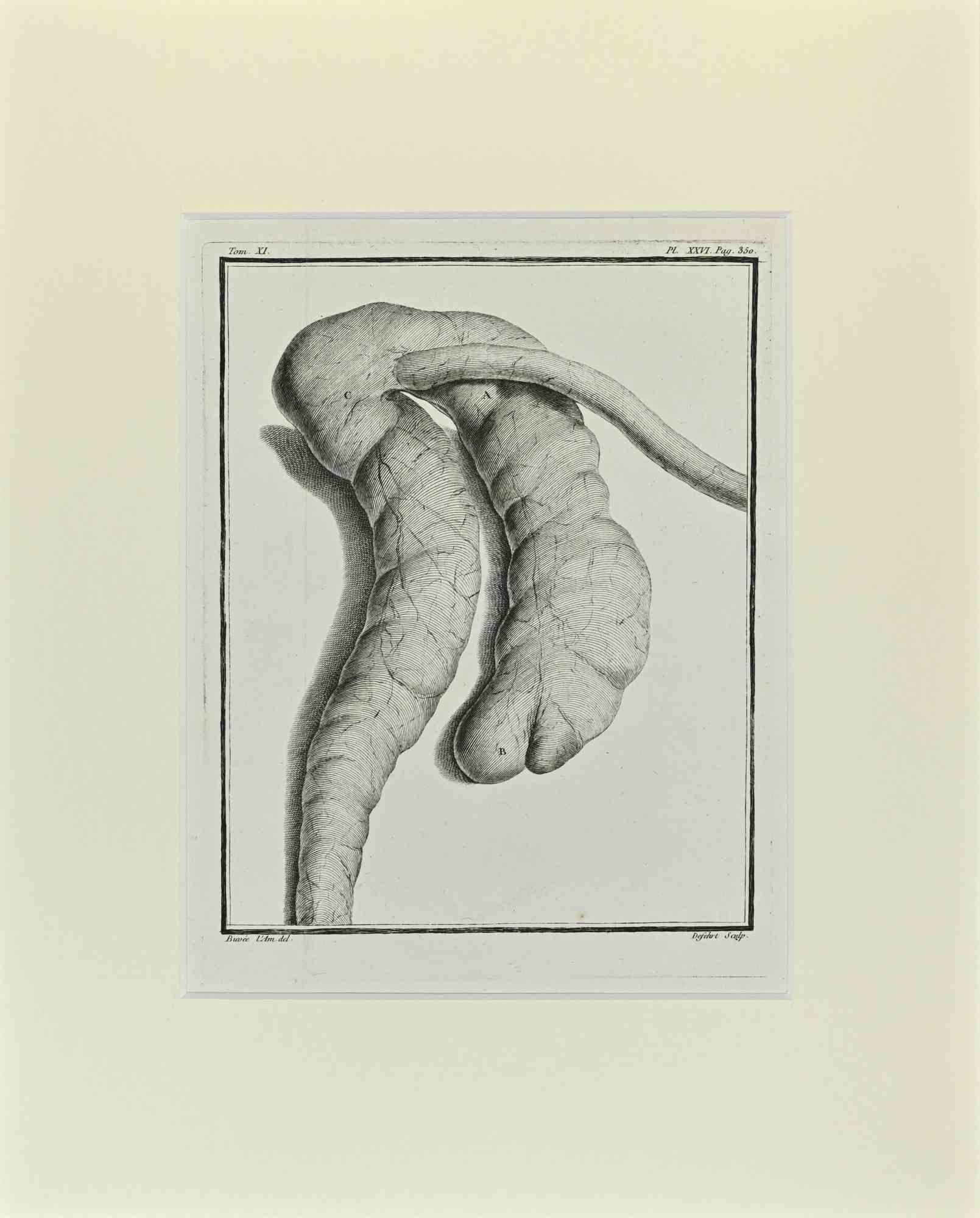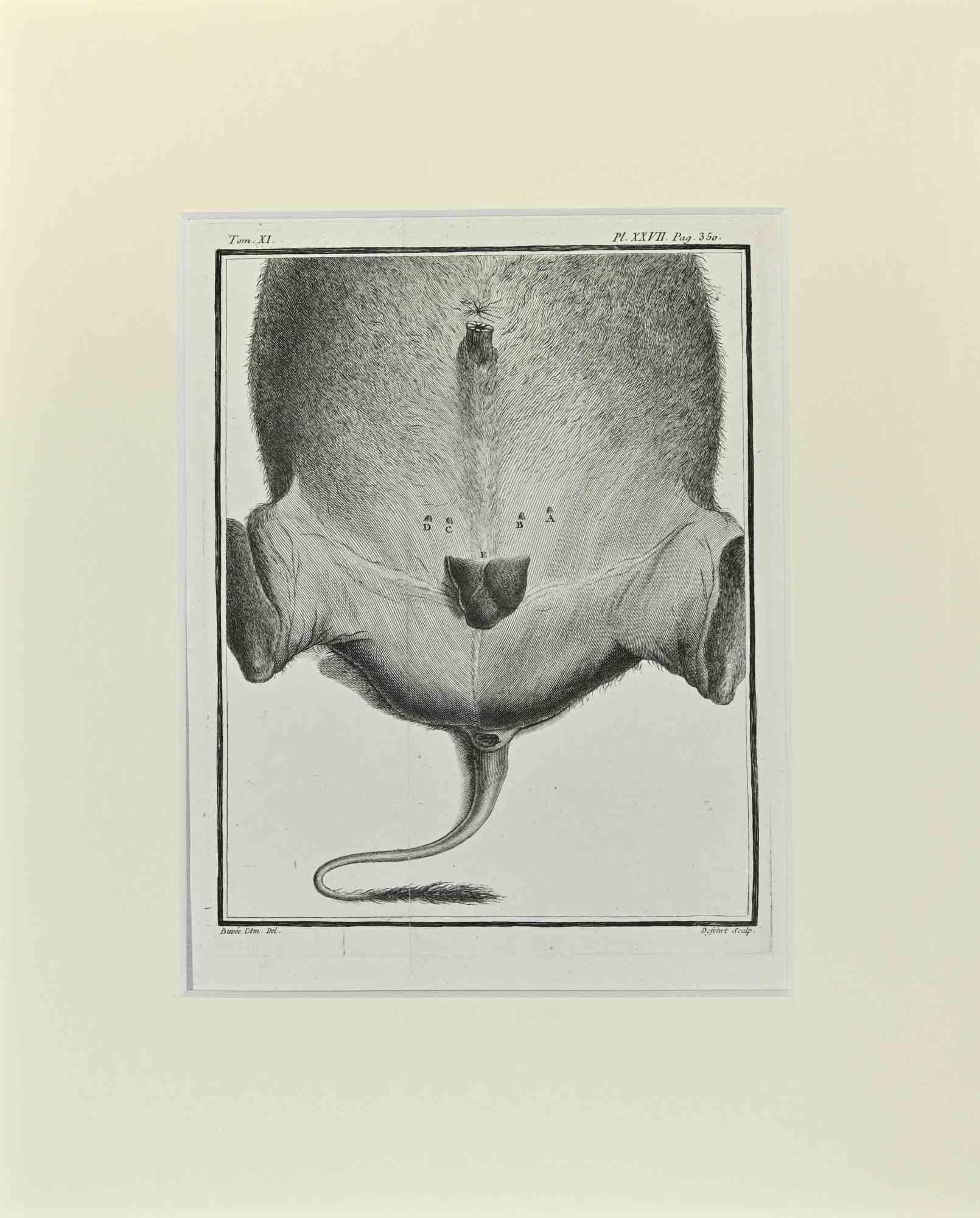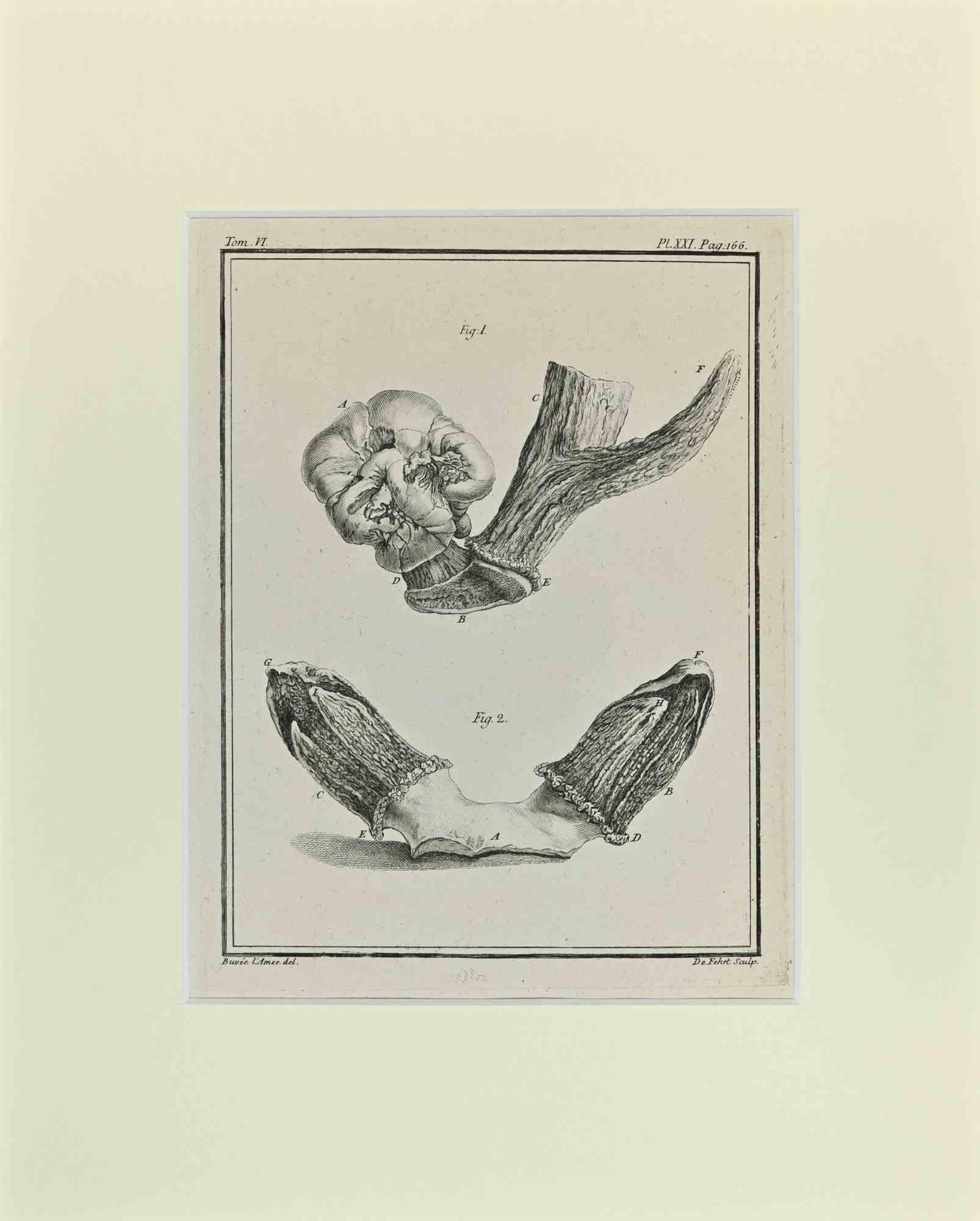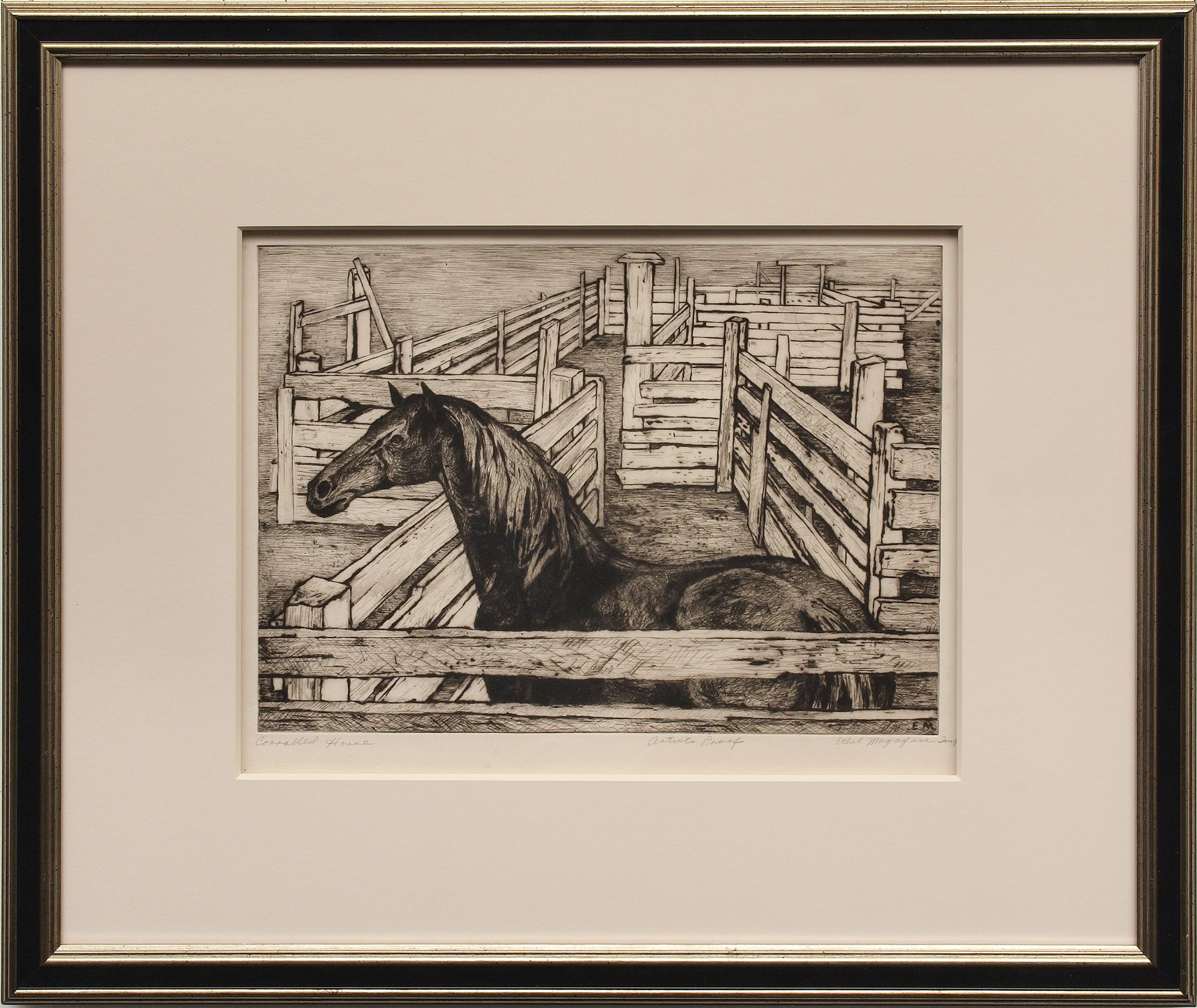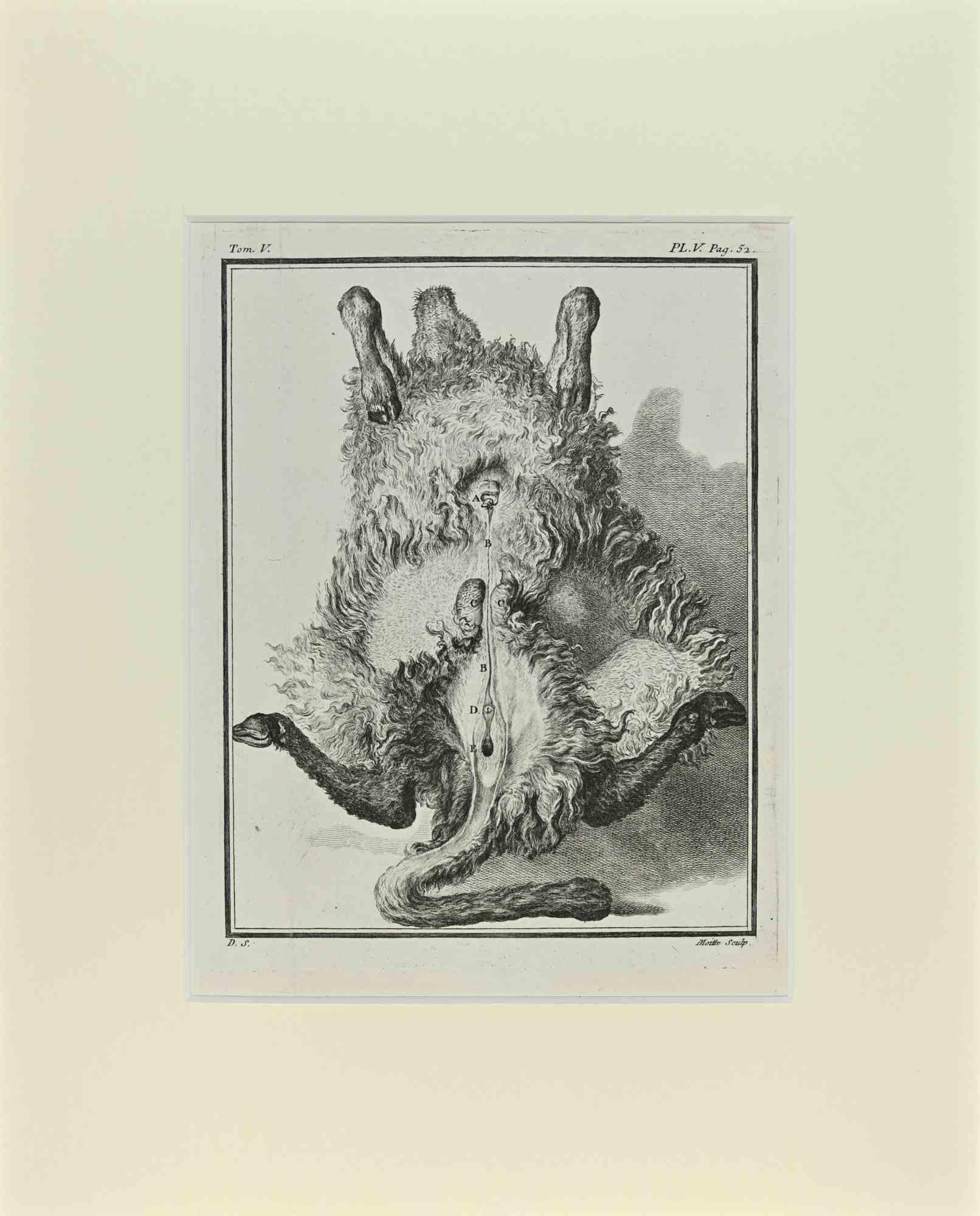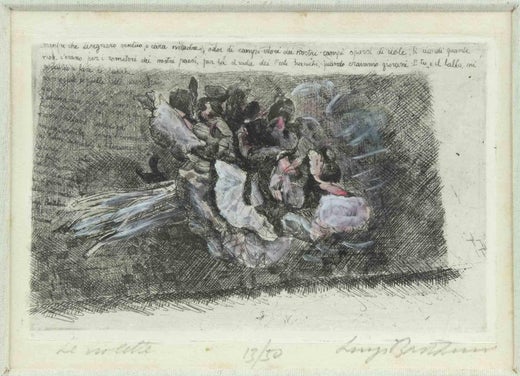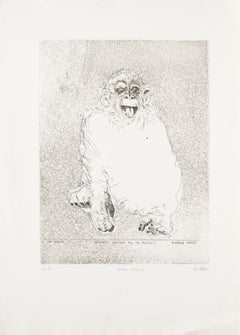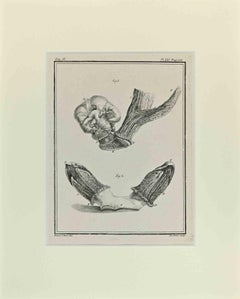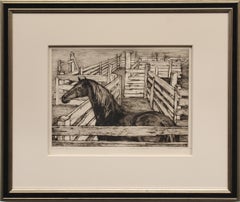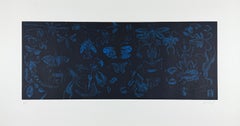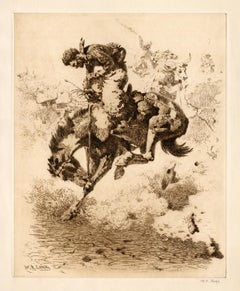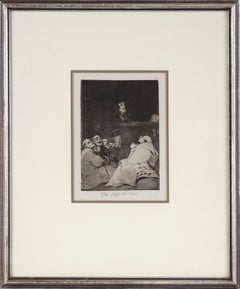Items Similar to Le Trote - Etching by Luigi Bartolini - 1934
Want more images or videos?
Request additional images or videos from the seller
1 of 6
Luigi BartoliniLe Trote - Etching by Luigi Bartolini - 19341934
1934
About the Item
Image dimensions: 27 x 32.7 cm.
Le Trote ("The Trouts") is original artwork realized by the Italian artist, poet and engraver Luigi Bartolini in 1934.
Very rare etching on rigid paper. Plate dimensions: mm 270 x 327.
Titled in pencil on the lower left corner: Le Trote; numbered in pencil on the lower central margin: 12/50; hand-signed by the artist on the lower right corner: Luigi Bartolini.
Excellent conditions.
Othe titled: Le tre trote; Le trote. Storia d'una passeggiata in campagna.
The same work is also present in the collection of the Galleria d’Arte Moderna e Contemporanea Lorenzo Viani in Viareggio, Italy.
Bibliography:
1951 - Petrucci-Calcografia, n. 493 e.u. (1934), n 578 es. 30 (1936)
1952 - Gli esemplari unici o rari, p. 119 – Casini
1962 - Ronci-Calcografia, n. 493 e.u. (1934), n 578 es. 30 (1936)
1972 - Barsanti-Gall. Marino, n. 559 nel 1934 (e.u.), n. 661; nel 1936 (es. 50)
1984 - Appella-Bartolini incisore - L’Attico-EsseArte Roma
1989 - Appella-L’uomo, l’artista, lo scrittore - Macerata, n. 190
1997 - Ficacci-Bartolini alla Calcografia - Roma, n. 493
1998 - Micieli-Mino Rosi e Luigi Bartolini n. 42
Selected Exhibitions:
1939 Ancona, VII Mostra d’Arte
1941 Roma, Mostra Galleria di Roma
1942 Roma, Mostra Reale Galleria d’Arte Moderna
1942 Venezia, XXIII Biennale
1949 Parigi, Mostra Internazionale d’Incisione Contemporanea
1951 Roma, Mostra Calcografia n. 493
1960 Ancona, Mostra Galleria Puccini
1961 Bari, Mostra Galleria La Vernice
1962 Torino, Mostra Galleria Narciso
1962 Roma, Mostra Calcografia, n. 493
1966 Torino, Antologica Palazzo del Valentino
1970 Vienna, Wiener Secession
1989 Macerata, Mostra Palazzo Ricci
1997 Urbino - Luigi Bartolini alla Calcografia, Palazzo Ducale, Sala del Castellare, ottobre 1997, cat.p.155, n°72
This artwork is shipped from Italy. Under existing legislation, any artwork in Italy created over 70 years ago by an artist who has died requires a licence for export regardless of the work’s market price. The shipping may require additional handling days to require the licence according to the final destination of the artwork.
- Creator:Luigi Bartolini (1892 - 1963, Italian)
- Creation Year:1934
- Dimensions:Height: 13.39 in (34 cm)Width: 16.15 in (41 cm)Depth: 0.08 in (2 mm)
- Medium:
- Period:
- Condition:Insurance may be requested by customers as additional service, contact us for more information.
- Gallery Location:Roma, IT
- Reference Number:Seller: J-457931stDibs: LU65035801752
Luigi Bartolini
Luigi Bartolini was an Italian painter, writer and poet. He is best known for his novel, Bicycle Thieves, upon which the Italian neorealist film of the same title, directed by Vittorio De Sica, was based. He published more than 70 books during his lifetime.
About the Seller
4.9
Platinum Seller
Premium sellers with a 4.7+ rating and 24-hour response times
1stDibs seller since 2017
7,496 sales on 1stDibs
Typical response time: 2 hours
- ShippingRetrieving quote...Shipping from: Roma, Italy
- Return Policy
Authenticity Guarantee
In the unlikely event there’s an issue with an item’s authenticity, contact us within 1 year for a full refund. DetailsMoney-Back Guarantee
If your item is not as described, is damaged in transit, or does not arrive, contact us within 7 days for a full refund. Details24-Hour Cancellation
You have a 24-hour grace period in which to reconsider your purchase, with no questions asked.Vetted Professional Sellers
Our world-class sellers must adhere to strict standards for service and quality, maintaining the integrity of our listings.Price-Match Guarantee
If you find that a seller listed the same item for a lower price elsewhere, we’ll match it.Trusted Global Delivery
Our best-in-class carrier network provides specialized shipping options worldwide, including custom delivery.More From This Seller
View AllHomo Ludens - Etching by Sergio Barletta - 1991
By Sergio Barletta
Located in Roma, IT
Homo Ludens is an original etching artwork, realized by Sergio Barletta in 1991.
Hand-signed on the lower right in pencil, and titled on the lower center "Homo Ludens". Numbered on ...
Category
1990s Modern Figurative Prints
Materials
Etching
Anatomy of Animals - Etching by Antoine Defehrt - 1771
Located in Roma, IT
Anatomy of Animals is an etching realized by Antoine Defehrt in 1771.
It belongs to the suite "Histoire naturelle, générale et particulière avec la description du Cabinet du Roi".
...
Category
1770s Modern Figurative Prints
Materials
Etching
Anatomy of Animals - Etching by Antoine Defehrt - 1771
Located in Roma, IT
Anatomy of Animals is an etching realized by Antoine Defehrt in 1771.
It belongs to the suite "Histoire naturelle, générale et particulière avec la description du Cabinet du Roi".
...
Category
1770s Modern Figurative Prints
Materials
Etching
Anatomy of Animals - Etching by Antoine Defehrt - 1771
Located in Roma, IT
Anatomy of Animals is an etching realized by Antoine Defehrt in 1771.
It belongs to the suite "Histoire naturelle, générale et particulière avec la description du Cabinet du Roi".
...
Category
1770s Modern Figurative Prints
Materials
Etching
Anatomy of Animals - Etching by Jean Moitte - 1771
Located in Roma, IT
Anatomy of Animals is an etching realized by Jean Gullaume Moitte in 1771.
The artwork Belongs to the suite "Histoire naturelle, générale et particulière avec la description du Cabi...
Category
1770s Modern Figurative Prints
Materials
Etching
Abeilles - Etching by Alfred Emile Méry - 1866
By Alfred Emile Mery
Located in Roma, IT
Abeilles is a black and White etching realized by Alfred Emile Méry in the 1866.
Titled in the lower.
Image size:24x31.
Very good impression with wide margins and a very fresh in...
Category
1860s Modern Figurative Prints
Materials
Etching
You May Also Like
Corralled Horse (Artists Proof), 1940s Framed American Modernist Horse Etching
By Ethel Magafan
Located in Denver, CO
"Corralled Horse", is an etching on paper by western artist Ethel Magafan (1916-1993) of a single dark horse standing outside in a wooden fenced corral. Presented in a custom frame, outer dimensions measure 19 x 23 inches. Image size is 10 x 14 inches. This is marked as an Artist Proof
Piece is in very good condition - please contact us for a detailed condition report.
Provenance: Estate of Artist, Ethel Magafan
Expedited and international shipping is available - please contact us for a quote.
About the Artist:
Ethel Magafan
Born 1916
Died 1993
The daughter of a Greek immigrant father and a Polish immigrant mother who met and married in Chicago, Ethel Magafan, her identical twin sister Jenne and their elder sister Sophie grew up in Colorado to which their father relocated the family in 1919. They initially lived in Colorado Springs where he worked as a waiter at the Antlers Hotel before moving to Denver in 1930 to be head waiter at the Albany Hotel. Two years later during the Great Depression Ethel and Jenne experienced at sixteen the tragic loss of their father who had encouraged their artistic aspirations.
He was proud when Ethel, a student at Morey Junior High School, won top prizes in student poster contests sponsored by the Denver Chamber of Commerce and the Denver Post. At East High School in Denver she and Jenne contributed their art talents to the school’s and by their senior year were co-art editors of the Angelus, the 1933 yearbook. At East they studied art with Helen Perry, herself a student of André Lhote in Paris and the Art Institute of Chicago. Her decision to abandon an arts career to teach high school students served as an important example to Ethel and Jenne, who early on had decided to become artists. In a city-wide Denver competition for high school art students Ethel won an eighteenweek art course in 1932-33 to study at the Kirkland School of Art which artist Vance Kirkland had recently established in the Mile High City.
Perry encouraged the Magafan twins’ talent, exposing them to the work of Matisse, Picasso and Cézanne and introducing them to local artists and architects like Frank Mechau and Jacques Benedict whom she invited to speak in her high school art classes. She paid the modest tuition for Ethel and Jenne to study composition, color, mural designing and painting at Mechau’s School of Art in downtown Denver in 1933-34. In the summer of 1934 and for a time in 1936 they apprenticed with him at his studio in Redstone, Colorado.
When they returned to Denver in 1934 with no family breadwinner to support them, their mother insisted that they have real jobs so they worked as fashion artists in a Denver department store. When Jenne won the Carter Memorial Art Scholarship ($90.00) two years later, she shared it with Ethel so that both of them could enroll in the Broadmoor Art Academy (now the Colorado Springs Fine Arts Center) where they studied with Mechau. When the scholarship money ran out after two months, he hired them as his assistants. Along with Edward (Eduardo) Chavez and Polly Duncan, they helped him with his federal government mural commissions. At the Fine Arts Center Ethel also studied with Boardman Robinson and Peppino Mangravite, who hired her and Jenne in 1939 to assist him in his New York studio with two murals commissioned for the post office in Atlantic City, New Jersey. Like their Denver high school art teacher, Robinson also stressed the need to draw from nature in order to "feel" the mountains, which later become the dominant subject matter of Ethel’s mature work after World War II.
Mechau trained her and her sister in the complex process of mural painting while they studied at the Colorado Springs Fine Arts Center, teaching them the compositional techniques of the European Renaissance masters. This also involved library research for historical accuracy, small scale drawing, and Page 2 of 4 the hand-making of paints and other supplies. Ethel recalled that their teacher "was a lovely man but he was a hard worker. He drove us. There was no fooling around."
Her apprenticeship with Mechau prepared her to win four national government competitions, beginning at age twenty-two, for large murals in U.S. post offices: Threshing – Auburn, Nebraska (1938), Cotton Pickers – Wynne, Arkansas (1940), Prairie Fire – Madill, Oklahoma (1940), and The Horse Corral – South Denver, Colorado (1942). In preparation for their commissions Ethel and her sister made trips around the country to pending mural locations, driving their beat-up station wagon, dressed in jeans and cowboy boots with art supplies and dogs in tow. She and Jenne combined their talents in the mural, Mountains in Snow, for the Department of Health and Human Services Building in Washington, DC (1942). A year later Ethel executed her own mural, Andrew Jackson at the Battle of New Orleans, January 8, 1814, for the Recorder of Deeds Building, also in Washington, DC. Her first mural commission, Indian Dance, done in 1937 under the Treasury Department Art Project for the Senate Chamber in the United States Capitol, has since disappeared.
Ethel and her sister lived and worked in Colorado Springs until 1941 when their residence became determined by the wartime military postings of Jenne’s husband, Edward Chavez. They moved briefly to Los Angeles (1941-42) and then to Cheyenne, Wyoming, while he was stationed at Fort Warren, and then back to Los Angeles for two years in 1943. While in California, Ethel and Jenne executed a floral mural for the Sun Room of the Beverly Hills Hotel and also painted scenes of the ocean which they exhibited at the Raymond and Raymond Galleries in Beverly Hills. While in Los Angeles they met novelist Irving Stone, author of Lust for Life, who told them about Woodstock, as did artists Arnold Blanch and Doris Lee (both of whom previously taught at the Colorado Springs Fine Arts Center school. In summer of 1945 Ethel, her sister and brother-in-law drove their station wagon across the country to Woodstock which became their permanent home.
A year later Ethel married artist and musician, Bruce Currie, whom she met in Woodstock. In 1948 with the help of the GI Bill they purchased an old barn there that also housed their individual studios located at opposite ends of the house. The spatial arrangement mirrors the advice she gave her daughter, Jenne, also an artist: "Make sure you end up with a man who respects your work…The worst thing for an artist is to be in competition with her husband."
In 1951 Ethel won a Fulbright Scholarship to Greece where she and her husband spent 1951-52. In addition to extensively traveling, sketching and painting the local landscape, she reconnected with her late father’s family in the area of Messinia on the Peloponnese peninsula in southern Greece. At the same time, her sister Jenne accompanied Chavez on his Fulbright Scholarship to Italy where they spent a productive year painting and visiting museums. Shortly after returning home, Jenne’s career was cut tragically short when she died of a cerebral hemorrhage at age thirty-six. It deeply affected Ethel whose own work took on a somber quality for several years conveyed by a darkish palette, as seen in her tempera painting, Aftermath (circa 1952).
In the 1940s Ethel and her sister successfully made the important transition from government patronage to careers as independent artists. Ethel became distinguished for her modernist landscapes. Even though Ethel became a permanent Woodstock resident after World War II, from her childhood in Colorado she retained her love of the Rocky Mountains, her "earliest source of my lifelong passion for mountain landscape." She and her husband began returning to Colorado for annual summer camping trips on which they later were joined by their daughter, Jenne.
Ethel did many sketches and drawings of places she found which had special meaning for her. They enabled her to recall their vital qualities which she later painted in her Woodstock studio, conveying her feeling about places remembered. She also produced a number of watercolors and prints of the Colorado landscape that constituted a departure from the American Scene style of her earlier paintings. Her postwar creative output collectively belongs to the category of landscape abstractionists as described by author Sheldon Cheney, although to a greater or lesser degree her work references Colorado’s mountainous terrain. She introduced a palette of stronger pastels in her paintings such as two temperas, Evening Mountains from the 1950s and Springtime in the Mountains from the early 1960s.
In 1968 she was elected an Academician by the National Academy of Design in New York. Two years later, based on results of her many summer trips to Colorado, the U.S. Department of the Interior invited her to make on-the-spot sketches of the western United States, helping to document the water resources development and conservation efforts by the Department of the Interior. Her sketches were exhibited at the National Gallery in Washington, DC, and then sent on a national tour by the Smithsonian Institution. Similarly, her previous work as a muralist earned her a final commission at age sixty-three for a 12 by 20 foot Civil War image, Grant in the Wilderness, installed in 1979 in the Chancellorsville Visitors Center at the Fredericksburg National Military Park in Virginia. In the 1970s, too, she taught as Artist-in-Residence at Syracuse University and at the University of Georgia in Athens.
Her many awards include, among others, the Stacey Scholarship (1947); Tiffany Fellowship (1949); Fulbright Grant (1951-52, in Greece with her husband); Tiffany Fellowship (1949); Benjamin Altman Landscape Prize, National Academy of Design (1955); Medal of Honor, Audubon, Artists (1962); Henry Ward Granger Fund Purchase Award, National Academy of Design (1964); Childe Hassam Fund Purchase Award, American Academy of Arts and Letters (1970); Silver Medal, Audubon Artists (1983); Champion International Corporation Award, Silvermine Guild, New Canaan, Connecticut (1984); John Taylor Award, Woodstock Artists Association, Woodstock, New York (1985); Harrison Cady...
Category
1940s American Modern Figurative Prints
Materials
Paper, Etching
"Blue Butterflies" 2014 signed unique Bon A Tirer original engraving etching
By Sergio Hernández
Located in Miami, FL
Sergio Hernández (Mexico, 1957)
'Blue Butterflies', 2014
Engraving, etching, aquatint, sugarlift on paper
22.5 x 42 in.
Series number: BAT (Bon a Tirer)
Unframed
...
Category
2010s Contemporary Animal Prints
Materials
Paper, Engraving, Etching, Aquatint, Ink
'Foul Rope (Left)' — Early American Southwest Rodeo
By William Robinson Leigh
Located in Myrtle Beach, SC
William Robinson Leigh, 'Foul Rope (Left)', etching, c. 1920, edition unknown but small. Signed in pencil and signed in the plate, lower left. A superb, richly-inked impression, in dark brown ink, on buff wove Umbria paper, the full sheet with margins (1 1/2 to 2 3/4 inches); slight toning at the sheet edges, otherwise in excellent condition. Very scarce. Archivally matted to museum standards, unframed.
Image size 14 7/8 x 11 15/16 inches (378 x 303 mm); sheet size 20 3/8 x 15 3/8 inches (518 x 391 mm).
ABOUT THE ARTIST
Born near Falling Waters, West Virginia, on a plantation a year after the Civil War and raised in Baltimore, William Robinson Leigh (1866 - 1955) became one of the foremost painters of the American West. His career spanning some seventy-five years, Leigh created some of the most iconic depictions of the Western landscape, with admirers referring to him as ‘The Sagebrush Rembrandt.’
The son of impoverished Southern aristocrats, Leigh received his first art training at age 14 from Hugh Newell at the Maryland Institute, where he was regarded as the best student in his class. From 1883 to 1895, he studied in Europe, mainly at the Royal Academy in Munich with Ludwig Loefftz. From 1891 to 1896, he painted six cycloramas or murals in the round, a giant German panorama.
In 1896, Leigh began working as a magazine illustrator for Scribner's and Collier's Weekly Magazine in New York City. He also painted portraits, landscapes, and genre scenes.
Leigh's trips to the Southwest began in 1906 when he agreed to paint the Grand Canyon with William Simpson, Santa Fe Railway advertising manager, in exchange for free transportation West. In 1907, he completed his Grand Canyon painting, which led to more commissions and an extensive painting trip through Arizona and New Mexico. These travels inspired him to paint western subjects for the next 50 years, and his primary interests were the Hopi and Navajo Indians.
In 1910, he traveled to Wyoming, where he painted in Yellowstone Park and created sketches, many of which he later converted into large canvases such as ‘Lower Falls of the Yellowstone’ (1915) and ‘Grand Canyon of the Yellowstone’ (1911).
In 1926, he traveled to Africa at the invitation of Carl Akeley for the American Museum of Natural History, and from this experience, wrote and illustrated 'Frontiers of Enchantment: An Artist's Adventures in Africa'. In 1933, he wrote and illustrated 'The Western Pony'. His adventures were chronicled in several popular magazines, including Life, the Saturday Evening Post, and Colliers.
For many years, Grand Central Art Galleries at the Biltmore Hotel handled his work exclusively in New York. In 1953, Leigh was elected an associate member of the National Academy of Design and became a full Academician in 1955.
In March 1999, the Historical Center of Cody, Wyoming, held an exhibition of his field sketches and finished works depicting his experiences near Cody early in the century. Between 1910 and 1921, when he often painted in the Carter Mountain vicinity, these years were considered pivotal to his artistic development and devotion to the Western landscape.
Leigh's work is held in many museum collections of American Western art...
Category
1920s Realist Animal Prints
Materials
Etching
"Que pico de Oro" (What a Golden Beak) - Etching and Aquatint on Paper
By Francisco Goya
Located in Soquel, CA
"Que pico de Oro" (What a Golden Beak) - Etching and Aquatint on Paper
5th or 8th edition print of "Que pico de Oro" from the Los Caprichos with burnished aquatints, drypoints etchi...
Category
1790s Northern Renaissance Figurative Prints
Materials
Engraving, Etching, Aquatint, Laid Paper
The Wild Cat (Chat Sauvage)
By Karl Bodmer
Located in Middletown, NY
Etching on cream laid paper, full margins. From Eaux-Fortes Animaux & Paysages. [Beraldi II.140.34] Henri Béraldi Les graveurs du XIXe siècle: Guide de l'amateur d'estampes modernes. Librairie L. Conquet, vol. XII, Paris, 1885–1892, cat. no. 34, p. 140.
__________
Well known in his native Germany as a watercolorist, Karl Bodmer had a rich experience exploring in North America in the 19th century, accompanying German explorer Prince Maximilian zu Wied-Neuwied as the official artist on an expedition which toured the Missouri River...
Category
Mid-19th Century Barbizon School Animal Prints
Materials
Laid Paper, Etching
Black Geese
By Winifred Austen
Located in San Francisco, CA
This artwork titled "Black Geese" 1934 is an original color aquatint by noted British artist Winifred Marie Louise Austen, 1876-1964. It is hand signed and titled in pencil by the artist. The image (plate mark) is 9 x 13.75 inches, sheet size is 10.30 x 16.5 inches. Published by Arthur Greatorax LTD, Grafton street, London. It is in excellent condition.
About the artist:
Born at Ramsgate, Kent on 12 July 1876, Winifred Austen only daughter of Josiah Austin, a Cornish naval surgeon, and his wife Fanny, née Mann. She amended the spelling of her surname from Austin to Austen from the time that she began to exhibit.
In 1892 the family moved to Hornsey, London from where Austin attended the London County Council School of Arts and Crafts, studying under Cuthbert Swan, an animal painter. I n 1899 Austen exhibited a picture of a lion at the Royal Academy and in all exhibited more than seventy pictures at the Academy, the last in 1961.
She worked in both oils and watercolor but Austen is most highly regarded as an etcher. In all she made some two hundred etched plates, beginning in 1906 with a series entitled The White Heron. She had particular feeling for birds and small mammals, and the naturalist Sir Peter...
Category
Mid-20th Century Realist Animal Prints
Materials
Aquatint

